OUR LIVES...TO LIVE (seeking a JUST world!)
By Chandran Gopalakrishnan (with inputs from the OLTOL team)
09 December, 2014
Countercurrents.org
Notes on a Film Festival at The FD Zone (Films Division, Mumbai), 31 Oct – 2 Nov 2014
Nearly lost amid the glitz, glamour and giant budgets of commercial films is the world of alternate cinema. Provocative, disturbing, moving, thoughtful, sensitive, hard-hitting, inspiring – these are some adjectives that could describe the Our Lives...To Live (OLTOL) film festival series presented by the International Association for Women in Radio and Television (IAWRT)'s India chapter.
The first OLTOL travelling film festival and long-term resource of 98 films and videos (‘NO! to gender violence') was launched at events in late 2012 and early 2013 in several Indian cities, towns, campuses and communities, as part of the worldwide One Billion Rising campaign against gender-based violence. The second edition (‘seeking a JUST world!'), curated in 2014, comprises 129 short and long works that depict a range of inequities, injustices, oppressions – and people's movements.
Recently, over three days and nine themed sessions, Mumbai viewers had the opportunity to view 33 films and videos from the second edition of OLTOL – animation, short fiction, documentaries, fiction features, community videos, student films – at the new Jean Bhownagary Hall at Films Division. Many of the filmmakers were present, and took part in panel discussions with activists, journalists, college professors, lawyers and others, engaging audiences in interactions that often continued during the breaks.
This article is meant to serve both as partial record of the event, based on the author's necessarily subjective impressions and notes, and as encouragement to others who might want to borrow DVDs from IAWRT India and hold their own Our Lives...To Live film festivals anywhere in the country, according to their own areas of interest or work.
Day 1
Introducing the festival, series curator Smriti Nevatia set the tone for the three days by questioning who comprised the ‘we' implicit in ‘Our Lives...To Live' and who ‘we' might end up excluding, wondering what ‘to live' might truly mean in a world that was free of prejudice, poverty and inequalities, and hoping the films and discussions might leave us somewhat introspective, even disturbed.
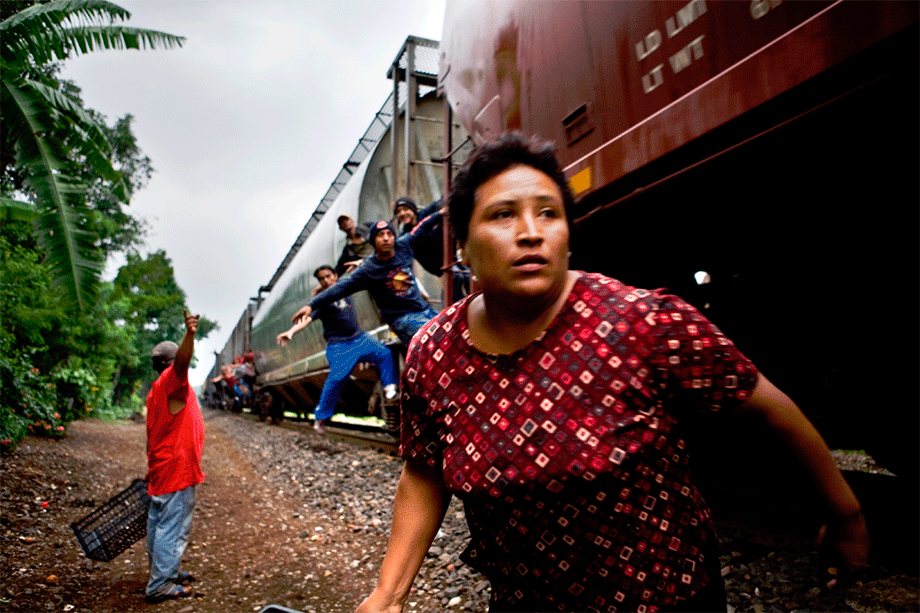
Maria in Nobody's Land
Session 1: Marginalisations – Disability, Caste, Poverty, Race...
Gülçin ( Nazli Eda Noyan, Turkey, 2013) , a short animation from Turkey, had a young girl narrating the story she is weaving on a carpet – of a landscape of happy flowers and playing children where deadly land mines maim and kill. Silence in a Noisy World ( Katrine Philp, National Film School of Denmark , 2008) brought us boisterous and expressive children in a Cairo boarding school for the deaf. Then, in keeping with The FD Zone tradition of including a film from the Film Division archives, They Call Me Chamar ( Loksen Lalwani, India, 1979) was screened. The film tells of a Brahmin man ostracised for marrying a Dalit woman. The session ended with a long and riveting documentary, Maria in Nobody's Land ( Marcela Zamora Chammoro, Mexico-El Salvador, 2010) , which follows three Salvadoran women on their illegal and dangerous journey through Mexico to the US. These four films flagged several concerns that resonated in the sessions to come – disability, prejudice, gender, conflict, nation, borders, the State.
Session 2: The State – Muzzling of Freedoms; Resistances
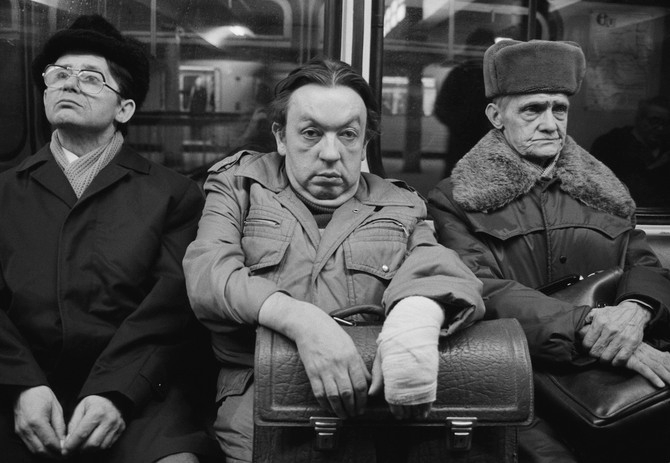
Cyclist
Made in Turkey ( Uçman Balaban, Turkey, 2014) , a one-minute animated montage of what happened over one recent year in Turkey, had many all-too-familiar elements – a ban on alcohol, media censorship, police and army brutality, a clampdown on public protests, mob violence. Cyclist ( Marc Thümmler, Germany , 2008) stunningly recounted how the Stasi spied on photographer Harald Hauswald, juxtaposing voiceovers of texts from the Stasi files with Hauswald's photographs to show the paranoia of the state and its harassment of common citizens – concerns equally at the heart of the next film.
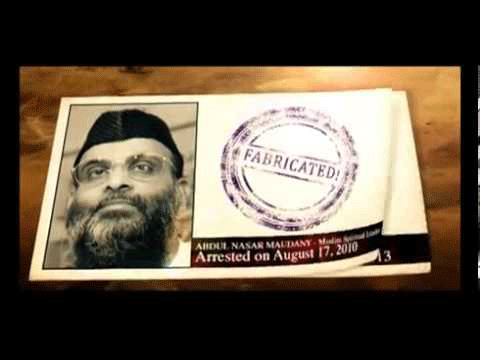
Fabricated
Fabricated ( KP Sasi , India , 2013) is a chilling account of the trumped-up charges filed against Abdul Nasar Maudany, a charismatic religious leader and supporter of marginalised people's struggles. It reminded us how many people – Muslims, Dalits, human rights activists, journalists – are implicated in false cases under questionable laws. This long documentary segued easily into Native Bapa ( Muhsin Parari , India , 2013) , a hip-hop music video that wittily and poignantly tells of the common plight of many Muslim families – a father's angst and a mother's sorrow when a son is branded a terrorist.
The first panel discussion of the festival had filmmakers KP Sasi and Sashi Kumar in conversation with Geeta Seshu, senior journalist, c onsulting editor of the media watch site The Hoot and coordinator of the Free Speech Hub . The case against Abdul Nasar Maudany and its wider implications were discussed at length. Maudany's People's Democratic Party has taken up the causes of the minorities, Adivasis, Dalits and people's movements against destructive forms of development, which may be the main reason for his being targeted. His forgiving the person who crippled him with a bomb, his acquittal in the first case against him and his being re-arrested on contrived evidence and being denied bail in spite of extreme ill health were described by Sasi, who also spoke of Shahina, the journalist charged with terrorism because she was investigating this fabrication of evidence by the state. There was some reflection on how fundamentalist forces tend to set the agenda for police arrests. The accounts given by the police are then carried uncritically by the mainstream media, and accepted as fact by the public. Thousands like Maudany, with much less public support, are languishing in jail. Sasi also expressed anguish at our silence (and ignorance) about the 300 churches burnt down by right-wing Hindutva forces in Odisha's Kandhamal region, pointing to how their depredations did not end with bringing down the Babri Masjid.
Another classic was then screened – Safdar ( Sashi Kumar for SAHMAT, India, 1989 ), followed by a discussion with the filmmaker. Made right after the shameful murder of Safdar Hashmi by politically-backed goons during his street theatre group's performance of Halla Bol , the film reconstructs the playwright-writer-activist's short life through archival materials and conversations. Sashi Kumar spoke of how difficult it had been to create a fitting tribute so soon after the incident. Along with other colleagues, Hashmi's wife Moloyshree decided to perform the play at the same venue just three days later, and that became the starting point for the film.
The audience, including people from the various movements who had known Safdar, and younger people not yet born then, spoke of being electrified by the film. Filmmaker Nishtha Jain spoke of acting in street plays in Delhi at the same time and in the same venues, and how well the film captured the spirit of those times. Many were deeply moved by the experience of viewing such a film together, and its relevance to our own grim present, as the concerns that Safdar Hashmi and his Jan Natya Manch highlighted remain as urgent as ever. Someone said the situation we find ourselves in today is partly due to the retreat of the Left, which in places like Bengal has become something of a joke. Others spoke of the need to show not just suffering, which could lead to despondency and a sense of futility, but to portray resistance and hope as well – as Safdar does.
Session 3: Fugitives from Hate
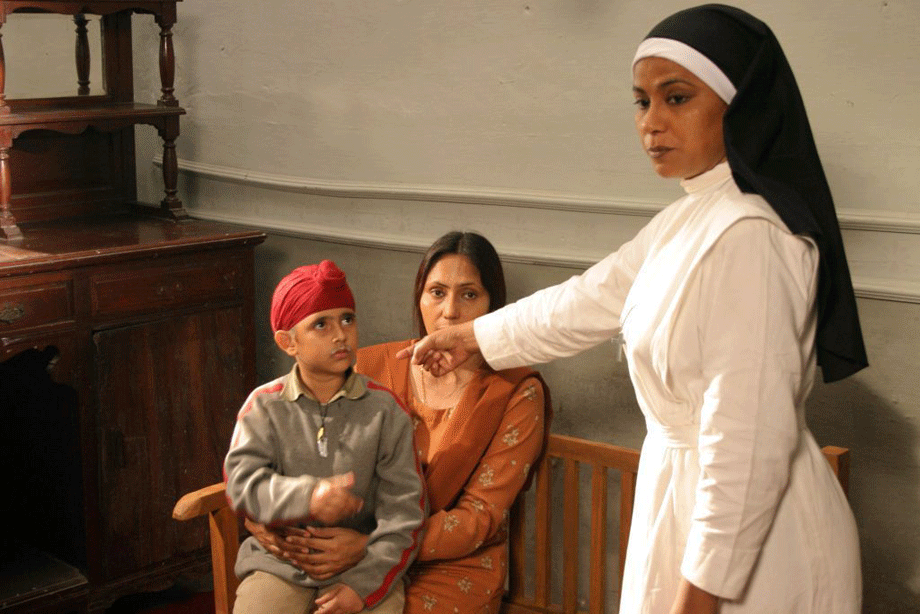
Kaya Taran
The evening session began with 5 Exchange Lane ( A nirban Dutta , India , 2014) , in which members of a displaced Kashmiri Pandit family revisit their old house in Srinagar after 12 years. Next was Ek Aakhri Panah (One Last Refuge; Tanvi Barge, Krishna Panchal, Piyush Garud, Juanita Mukhia, India, 2013) from the six-film series Remembering 1992 made by students and teachers at the School of Media and Cultural Studies, TISS, Mumbai. During the communal violence of December 1992 and January 1993 in Bombay , many Muslim families moved to safer areas like Mumbra, which this short film explores. We ended the day's screenings with the fiction feature Kaya Taran ( Sashi Kumar , India , 2004) whih straddled two traumatic events in recent Indian history: the 1984 anti-Sikh carnage following the assassination of Prime Minister Indira Gandhi, and the anti-Muslim violence in Gujarat in 2002.
An intense panel discussion followed, with many personal experiences being shared. Rohini Hensman, researcher, activist and novelist, was moderator-discussant. She began by speaking of herself as a fugitive from hate as well, referring to her family's flight from Sri Lanka when she was a child. Anirban Dutta, who had filmed his mother-in-law, wife and two children on their visit to Srinagar , spoke of how his wife's grandfather had at first refused to move out, but changed his mind after his granddaughters were threatened. Right now, the Kashmiri Muslims and Pandits do not believe each others' narratives. Displaced people have, in practical terms, no home to which to return. Piyush Garud was a child during the Mumbai riots, but some images haunted him, so he decided to make the film in Mumbra which he had always heard spoken of as ‘mini-Pakistan'. He wondered whether this ghettoisation could ever be reversed.
Trilokpuri, briefly shown in Kaya Taran , was a flashpoint once again, with simmering communal tensions, in the news while this film festival was on – and, by a strange coincidence, we found we had been watching the film precisely on the 40 th anniversary of Indira Gandhi's assassination. Sashi Kumar spoke of how Kaya Taran had to be labelled fiction to get a censor certificate. He told us that Rahul Singh, the real journalist interviewed by the fictional journalist at the start of the film, described what he had actually witnessed in words that had, through the retelling, become as deeply burned into his brain as the horrors he witnessed.
A series of commissions of enquiry set up after the various communal conflagrations over the years has failed to deliver justice to the victims and survivors. Rohini spoke of Insaaniyat, a group formed in Bombay that worked to reverse the assault on humanity that the Gujarat genocide represented. The issue of how we construct the Other came up. People have many identities. Through art we may also explore new possibilities – one way to give a positive spin is to remember not only the violence but the cases of people helping others at grave risk to themselves, especially when we consider how groups such as Panun Kashmir are emerging with one-dimensional narratives. It was felt that the dialogue generated through watching such films is particularly useful.
Day 2
Session 4: The State – Muzzling of Freedoms; Resistances (Part 2)
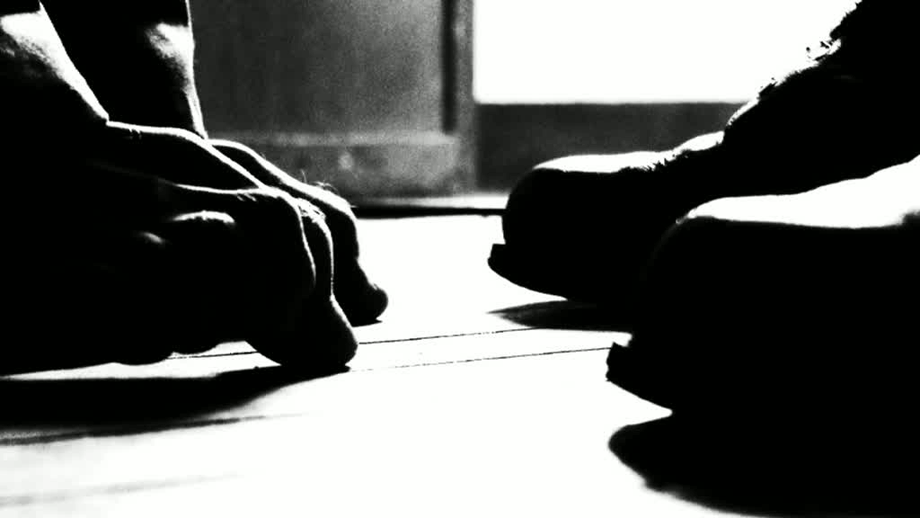
Interrogation
The first film of the morning was Interrogation ( Adam Palenta, Poland , 2010). In this short, a soldier recalls the tortures and humiliation he suffered at the hands of the Polish secret police. Exceptional in its formal treatment, the film explores the cruelty of the totalitarian system and the incredible human will to survive.
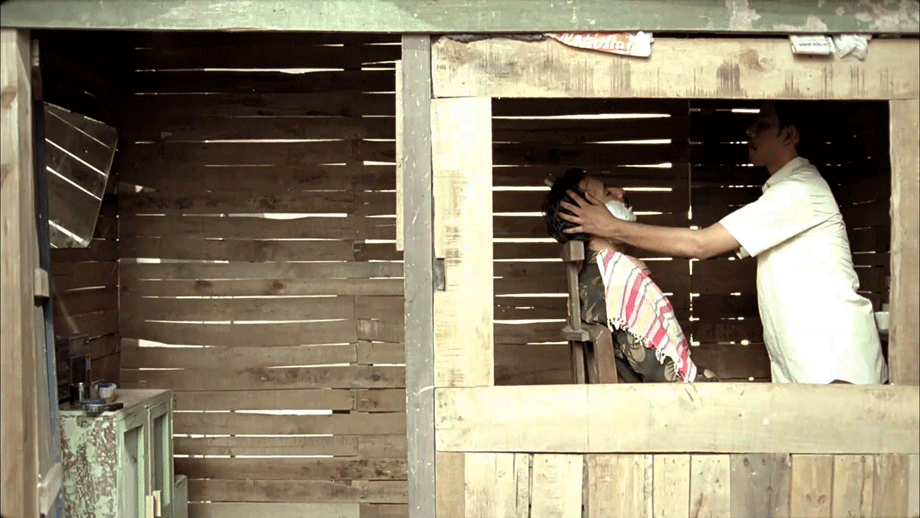
Dwand
In Dwand ( Abhilash Vijayan, Film and Television Institute of India, 2012) , based on a story by Spanish writer Hernando Tellez, the battle between Maoist rebels and the Army is played out in a barber's shop in a remote Chhattisgarh village.
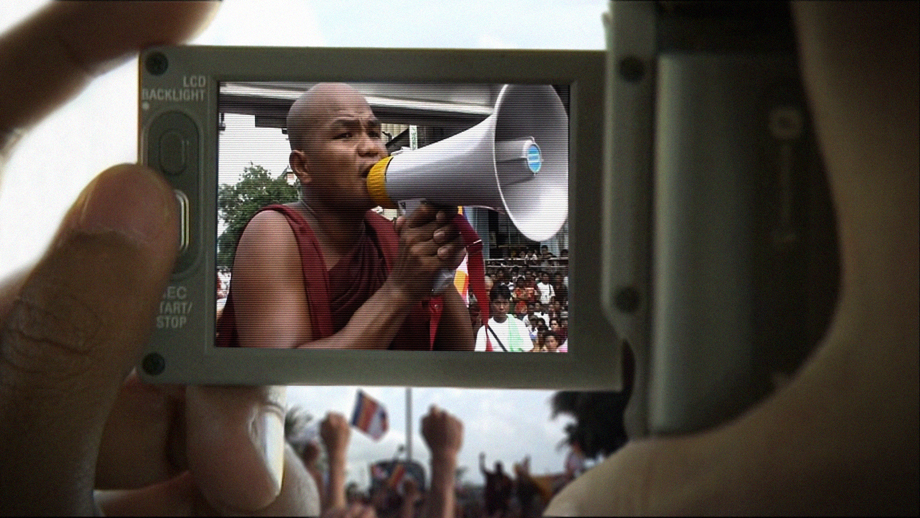
Burma VJ: Reporting from a Closed Country
The session's last film was the long documentary Burma VJ: Reporting from a Closed Country ( Anders Ø stergaard, Denmark-Burma, 2008). It captures the dramatic days of protest in September 2007 when undercover video journalists armed with small handycams risked jail and torture in order to keep up the flow of news from the streets of Rangoon.
Jairus Banaji, economic historian and Research Professor at SOAS ( University of London ), and MJ Pandey, trade unionist as well as independent media journalist and analyst, were on the panel. Both have a nuanced understanding of state repression, fascism and fundamentalism in history and in our times, and pulled no punches while drawing parallels between the films we had seen and the larger state of affairs in India . Smriti Nevatia joined them on the panel, in lieu of filmmaker Abhilash Vijayan who had been unable to make it. Burma VJ was described as a good example of guerrilla journalism. Though MJ felt it did not give us the background to the resistance movement or explain who its supporters and detractors were, Smriti argued that the film was mainly documenting a certain period rather than aiming to be a comprehensive historical essay, and Sashi Kumar spoke of how the ellipses made for a stronger film – the virtual presence of NGOs, the stealthy camera that itself becomes part of the action – so that a lot is left to the imagination. Jairus thought the gritty shots of prison architecture in Interrogation worked brilliantly as a metaphor for the state. In Dwand , the resistance was more subtle. There were many ironic moments: none of the locals understand what the ‘MOU' in the newspaper story means; a woman looking like Soni Sori passes by.
The panelists pointed out that the dichotomy between democracies and non-democracies is no longer clear. Behind the façade of democracy in India we have a deeply authoritarian state. Whether the ruling party is right, left or centre, it does not make much of a difference. The ‘illusion of the state' is sustained through fear. Jingoistic rules, like forcing people to stand up for the national anthem by playing it in cinema halls, further reduce the state to symbols, while one wonders how conversant – or concerned – are those standing at attention (and checking whether others are doing so or not) with the country's real issues and inequities. A major problem is the breakdown of the criminal justice system, which lets the powerful get away with murder. If those responsible for 1984 had been punished, mused MJ, 2002 may not have happened. Further, there seems to be a consensus in the corporate media – so we have hardly any coverage on J&K, the Northeast, the Maoist corridor, or workers' struggles.
MJ spoke of how films today are largely consumed at home rather than shared with a public audience, which greatly reduces their transformative impact. We also need to maintain our critical edge while watching the films we do. In the Burmese film, it was electrifying to catch a glimpse of Aung San Suu Kyi, then still under house arrest and an obvious hero for the protestors, and also to witness the hundreds of monks joining the protests in the streets. Yet Suu Kyi's own equivocal response to the role of the Buddhist monks in the recent atrocities against the Rohingya Muslims, possibly due to her efforts at reconciliation with the military junta, have cast her in a less flattering light.
Panelists and audience alike spoke of how the three films together made for an special viewing experience because of their connections and resonances. In their different ways, each showed the overwhelming might and unrestrained brutality of the state. Speaking of how cultures of protest have become diluted, a contrast was drawn between what we had seen in Safdar the previous day – when Shabana Azmi used the spotlight at a mainstream film festival to deflect the innocuous question asked by the anchor and issue a public statement protesting Safdar Hashmi's murder by a ruling party strongman – and today's conformist tendencies as exemplified by a film star who does television shows that are deemed progressive also attending a recent function at which the right-wing Prime Minister made a notoriously regressive speech while inaugurating a medical facility.
Session 5 : A Disaster Called Development
.gif)
Shot Dead For Development
Three shorts, all directed by Surya Shankar Dash for collectives in Odisha, opened the session. As grain is rhythmically pounded, Dhinki expounds the ‘secret' of the anti-POSCO people's movement; Displacement Colony takes a satirical look at Odisha's ‘Biggest Housing Project'; the animated Shot Dead For Development uses Adivasi art, set to an Adivasi song, in a tribute to all those shot dead for resisting mining and industrial activities on their lands. All this, in a total of 9 minutes of powerful cinema. Next was a longer documentary, Don't Cut My Head Off ( Somnath Batabyal, Matti Pohjonen, Kazimuddin Ahmed, Pradip Saha , India , 2012) , which moves between a Nagaland village and the Copenhagen Climate Meet . The title recalls a Naga folk song: two women must walk through a forest to attend a friend's wedding, but first they must negotiate with a head-hunter – just like the environmental activists have to negotiate with killers of another sort for survival. Then, keeping to the pattern of the short and succinct followed by the long and hard look, the last two works screened were the protest music video Gaon Chhodab Nahin ( KP Sasi, India, 2009) , asserting the land, resource and livelihood rights of Adivasis, and Radiation Stories Part 3: Koodankulam ( Amudhan RP, India, 2012) , made over years from within the spaces of the people's movement against the Koodankulam nuclear plant in Tamil Nadu, and reflecting its local, independent, non-violent and democratic ethos.
Joining filmmaker Pradip Saha on the panel were Sukla Sen, independent researcher, writer, human rights activist and member of CNDP (Coalition for Nuclear Disarmament and Peace), with filmmaker KP Sasi – whose films and writings have steadfastly questioned the dominant development model – wearing the moderator-discussant hat.
Sasi began by contextualising many of the tribal protests. Not only do they have a better quality of life than in the cities – better houses, clean water, nutritious food – their gods too are getting submerged or destroyed through dams and mining, something he felt matters hugely to the affected communities but urban activists feel uncomfortable addressing. Pradip Saha quoted Kerala Dalit leader CK Janu as saying, ‘You don't have to teach us about socialism, human rights, ecology and democracy. We have been practicing it for generations'. He talked about how the Naga woman in the documentary, Seno Tsuhah, who went with the large Indian delegation to the Copenhagen talks, actually believed that the negotiators would give everyone a fair hearing, while in reality the whole show was a complete mockery. Her village, Chizami, has a slow, rich life, and a crop diversity that are both now under threat.
Pradip went on to describe how, in the movement against climate change, capitalism had seen an opportunity to revive the dying nuclear industry. Sukla Sen informed us that only 1.89% of India 's energy comes from nuclear power. Worldwide, there are 67 nuclear plants under construction, down from 187 some years ago. Following Chernobyl and Fukushima , most countries have turned away from nuclear power. Of the many reactors planned for Koodankulam, only one has been commissioned, and one is under construction. The former has been under maintenance for much of the time while it is not clear when the latter will be completed. The Russian reactors have proven defective. Globally, nuclear power has followed the nuclear bomb, but here it may have been the other way around. All nuclear plants are bombs in waiting. Apart from the safety risks, the biggest issue is the disposal of nuclear waste – the planet has exceeded its capacity as a sink for wastes. And even if nuclear power were completely safe, in a true democracy the people should have the right to decide whether they want it or not. We are also close to peak production for oil, water, trace minerals and so on. And we are rendering everything poisonous.
The scientists do not have an answer as to how to handle nuclear waste, and this may be part of the reason why suicides and mental illnesses have become common in the atomic scientist community. The environmental economy is seen as a fringe economy, while nuclear energy is tied up with national honour in a particularly jingoistic way. The Right to Information Act may not be applied to the nuclear industry, which has protection under the Official Secrets Act. Only the Prime Minister and the nuclear establishment know what is going on. This is a challenge to democracy.
Inequality is deeply embedded in our political economy, which enables some industries to buy electricity at one-thousandth the cost that the home consumer pays. 28% of emissions come from the energy sector. The rich extract more, destroy more and dump more. The poor have very little extractive power. All these events can be seen as points on a developing curve. Profit does not occur anywhere in nature. It is a human construct. The capitalist model is standard across all political parties and its way is to invest, extract, value-add, sell, profit, invest.
Who are the ‘we' in ‘Our Lives to Live'? We sit in this room, dismayed by state policies against the marginalised. But do we recognise that much of what ‘we' already have is at ‘their' cost? Do we question, even recognise, our privileges? There is a peculiar blindness that dubs protestors as ‘enemies of the state'. The moderator concluded that we should not make hierarchies of struggles. Even defeated struggles are important. No struggle is completely unsuccessful. US media, during the pre-Iraq war protests referred to the people as the ‘next superpower'. The people's struggles against the dams on the Narmada have left us with a rich legacy. Similarly, the Koodankulam struggle and the various people's movements in the country today are very inspiring.
Session 6: Globalisation
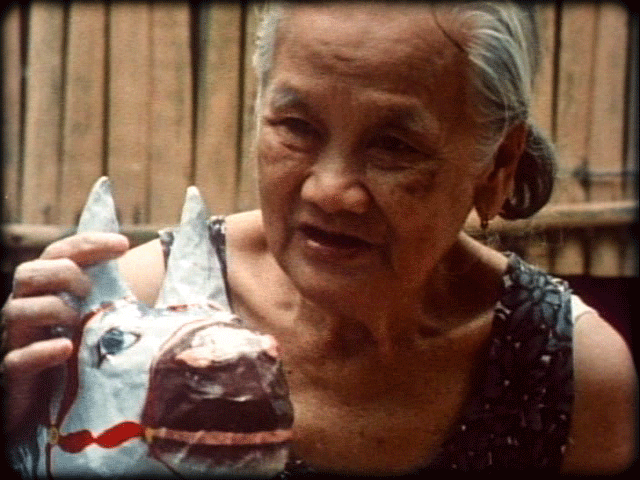
Turumba
The fiction feature Turumba ( Kidlat Tahimik, The Philippines, 1983) flowed naturally from the afternoon's session. Smriti spoke of how acquiring the celebrated iconoclastic filmmaker's classic for this festival had been a matter of serendipity, because a friend of hers happened to write on Facebook that she was in Manila and would be meeting Tahimik! Set in a small Philippines village, the film vividly shows the impact on family and community of a small-market handicraft being pushed into the global market economy. Sasi's remark about Adivasis losing not just their lands and livelihoods but their gods was fresh in our minds as we watched the villagers struggling to keep their traditional religious procession of Turumba alive.
Day 3
Session 7: Privileges and Exclusions
Introducing this session, the curator reiterated the idea that we could think about the inequities and injustices we ourselves perpetuate, and interrogate our own privileges of class, caste, ability, language, location. This means, of course, acknowledging their implicit and explicit exclusions as well. This is what the films in this session were in their own ways attempting.
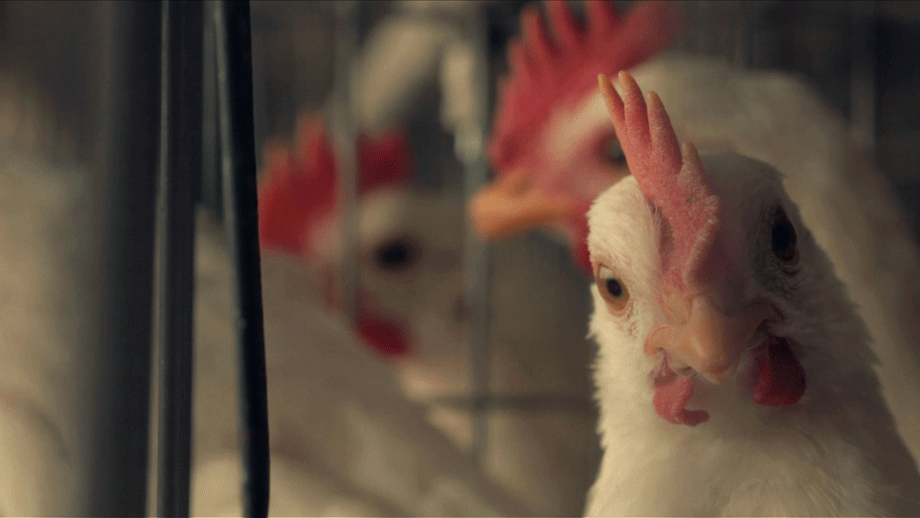
Give Us This Day Our Daily Bread
Give Us This Day Our Daily Bread ( Satchith Paulose, National Institute of Design , India , 2012) , set in a bleak consumerist landscape, employs subversive imagery to look at the deep-rooted social inequalities we are conditioned to ignore. Hamare Ghar ( Kislay, India, 2013) is a work of short fiction in which we may recognise our own hypocrisies in dealing with those we employ in our homes – the violence depicted here is not physical, but part of everyday actions and words. The two shorts were followed by a longer documentary, At My Doorstep ( Nishtha Jain, India, 2009) , which t akes us into the parallel world of those who service upper and middle class housing societies – the garbage collectors, laundrymen, delivery boys, watchmen.
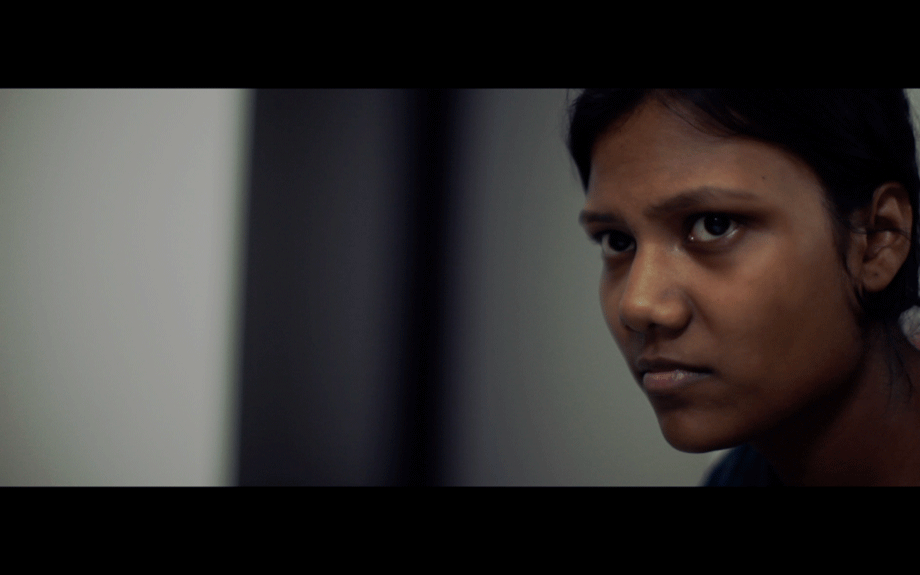
Hamare Ghar
Eeshit Narain, who shot and co-wrote Hamare Ghar , and filmmaker Nishtha Jain were on the panel, with moderator-discussant KP Jayasankar, Professor at the School of Media and Cultural Studies, TISS, Mumbai, whose films, co-directed with Anjali Monteiro, have won many national and international awards. Jayasankar began by saying that the three films had together created a remarkable dialogue, while striving for a new syntax to express certain realities that are usually invisible. Audience members keenly felt the shift of focus that had occurred, from the earlier subjects of state oppression, and flawed development policies, to these portrayals that implicated us directly, showing us an exploited class of workers who exist in our own spaces and whose presence and labour we take for granted. Eeshit spoke of Kislay's and his experience at FTII, with the film students being oblivious to the studio technicians having to work 12-hour shifts without overtime. But the larger student body got involved when the workers went on strike, which led to their minimum wages being revised. In Delhi , the crew interacted with the striking Maruti workers, which became a reference in the film via the TV news watched by the middle-class couple.
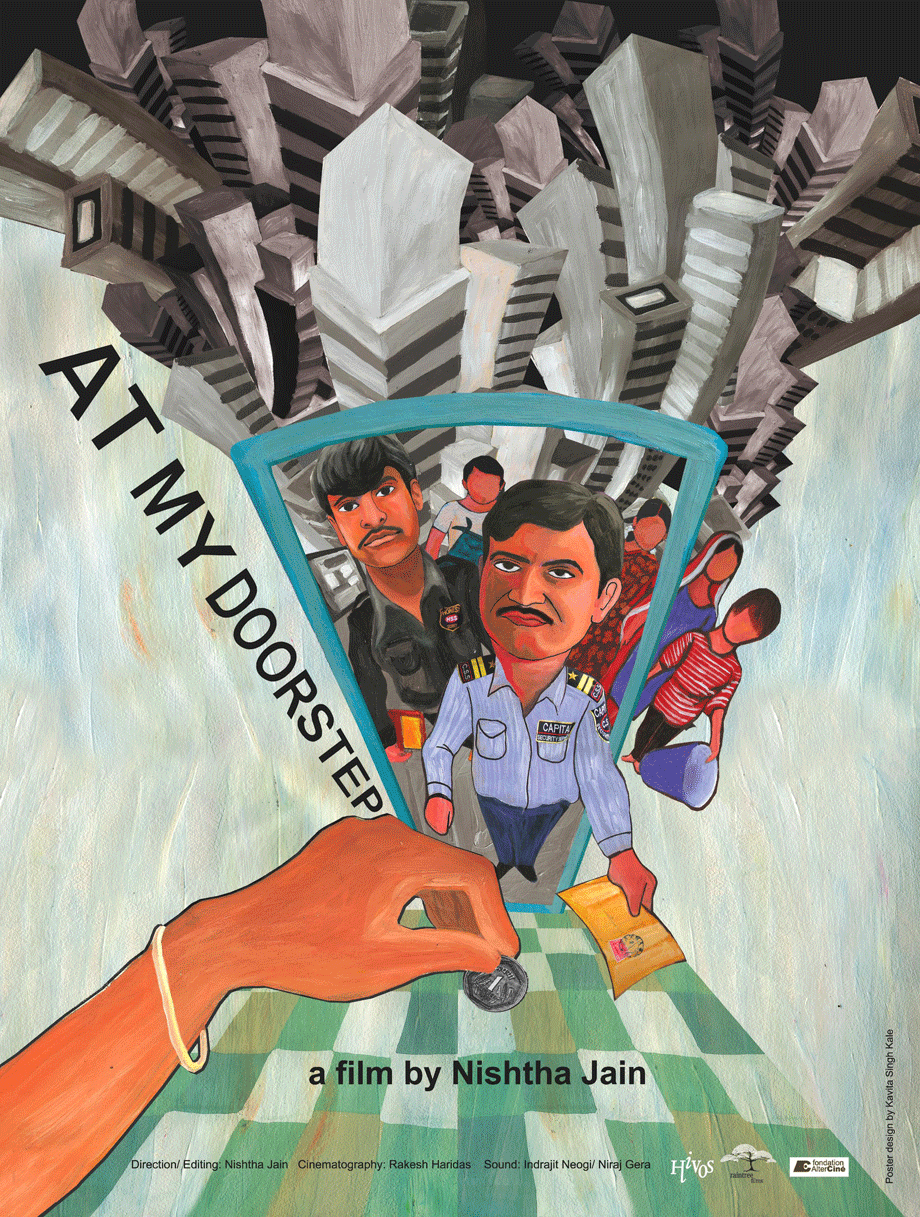
At My Doorstep
The dominant narrative of cinema has changed since the 1940s and '50s, when a number of stories featured poor and working class protagonists. Nishtha spoke of her earlier film Lakshmi and Me which looked closely at the relationship between herself and the woman working in her home. At My Doorstep emerged as a kind of sequel, exploring the situation of the mostly male workers who migrate to Bombay from states like Jharkhand (some dreaming of working in the cine industry). It was difficult to shoot – she was denied permission by various housing societies because they evidently suspected the film would not show them in a complimentary light. It was only for the Independence Day flag-hoisting that permission was readily granted – for what became one of the most ironic sequences in the film. The employees too were often reluctant to speak openly as they feared losing their already precarious jobs. Many of the men are too embarrassed even to inform their families back home about the precise nature of their menial labour – which may have to do with traditional notions of masculinity and honour. Women domestic workers seemed more self-assured, and have been able to organise, unlike the men in this non-formal sector.
Nishtha could never show the film in her own building, where it was mainly filmed, but screened it for members of her new housing society after she moved. There were objections that it was not ‘balanced' and that there are cases of far worse abuse than shown in the film! Eeshit spoke of screening Hamare Ghar at an MIG colony in Delhi , where the viewers were deeply moved, and there was a good deal of interaction. In our own audience at FD, one woman complained that housing society employees and domestic workers were paid much more than shown in the films, and yet they demanded money for each separate chore. Another person objected to this statement as a prime example of how we normalise injustice while hold on to the belief that some humans are inferior to ourselves, and that we are inherently entitled to their services. What would constitute a just salary for domestic work? Perhaps one that truly pinches the employer.
Session 7 (continued): Privileges and Exclusions
The afternoon session began with the familiar yet largely unacknowledged narrative of upper caste violence. After The Aftermath ( Kumud Ranjan , India , 2013) revisits Bathani Tola 16 years after the massacre there occurred, when the Patna High Court acquitted 23 of the convicted Ranveer Sena men. The video report brought us the shock and betrayal of the survivors, and formed a bridge between the previous discussion on social exclusions and the upcoming one on laws – in this context, the Prevention of Atrocities Act which is all too rarely invoked.
Session 8 : The Laws of Love & Death
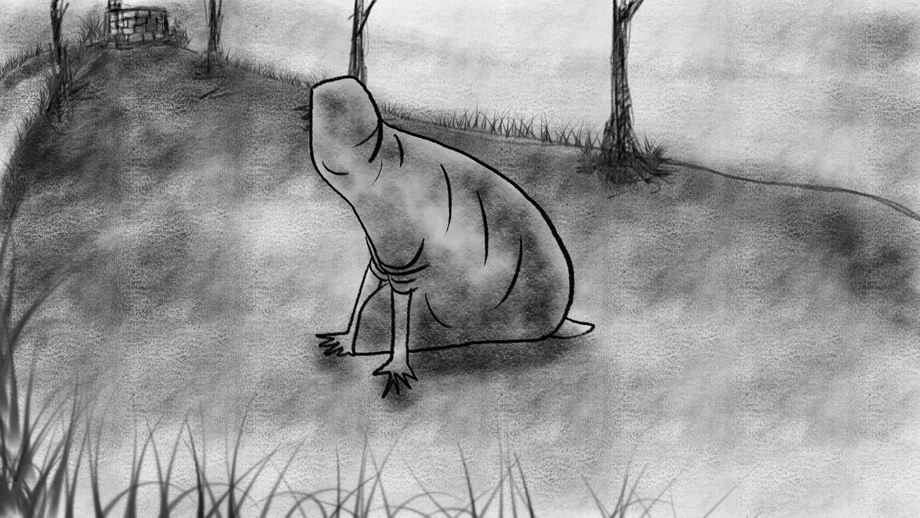
Chasni
With this session, the festival theme of ‘seeking a JUST world!' finally came home to roost, in a manner of speaking. Now it was Law itself, and the Justice (or otherwise) of the courts, that came under scrutiny. Chasni ( Abhishek Verma, Industrial Design Center , IIT Bombay , India , 2013) is an animation short in which the protagonist is an acid attack survivor, whose story is told through spoken word poetry as she negotiates the pitfalls of day-to-day life . Next we saw the feature documentary Article 61 ( Mahvash Sheikholeslami, Iran, 2005) which looks at how, despite the existence of a law that recognises self-defence as legitimate, in actual practice women are always in danger under the country's legal system even if they have been victims of male violence. How are women prisoners to get their rights in such circumstances? It was particularly chilling to see this film so soon after the hanging of Reyhaneh Jabbari in a similar case, despite the international appeals on her behalf. Our moods lifted somewhat with the screening of the defiant and celebratory music video Evening In Gay Maharashtra ( Natasha Mendonca, India, 2013) , a lively protest against the Supreme Court of India's reinstating of the homophobic Section 377 in December 2013. The last film took us from the laws around ‘love' (or violence in relationships meant to be loving, and laws against love) to the law of ‘death'. To Make an Example of ( Necati Sönmez, Turkey, 2007) , a documentary that humanely tackles the issue of capital punishment, finally banned in Turkey in 2002, was filmed in two deserted prisons where many executions were carried out. It asks: Why did we kill all these people? A sombre and disturbing film, it was of particular relevance in a country where the debate is far from settled, and bloodthirsty demands for the death penalty are heard more and more often.
To discuss these films, and the related laws, were filmmaker Abhishek Verma, women's rights lawyer Veena Gowda who has a wealth of experience with cases of violence against women, Lara Jesani, a graduate in criminal law and an active campaigner for the abolition of the death penalty in India, and moderator-discussant Anchal Jain, co-founder of Zehen, an intersectional feminist collective.
The panelists began by speaking of our often ambiguous relationship with the law, and its frequent misuse by the state for repression. When faced with heinous crimes, many of us want to give the same state the power to take life. In After the Aftermath the Patna High Court acquitted the killers, saying the evidence was not strong enough, whereas in the Parliament attack case, Afzal Guru was hanged based on flimsy circumstantial evidence. There is a lack of consistency and often of humanity in the way different cases are judged, with Muslims, Dalits, Adivasis and the poor being charged more often, more likely to be convicted and to receive harsher sentences. There is clearly a huge gap between law and its implementation, between the expectation of human rights and the delivery of justice.
The recent law recognising acid attacks as a separate offence, and restrictions on the sale and use of such materials, is helpful in curbing such attacks. Abhishek Verma spoke of how Chasni was inspired by a particular acid attack case that led him to research the subject. When he met the survivor in hospital, she had speech difficulties caused by the acid, and was worried about losing her job. He then met a victim-survivor who had married an activist, and another who had applied for euthanasia. Shirin Juwaley, also an acid attack survivor, started the NGO Palash for those affected by such attacks, or disfigurements due to other kinds of violence like slashing. There are some 9000 such persons, mostly women, in India . Most news reports focused on the violence, but hardly any on the experience of the victim after the event. Abhishek decided his film would be about a woman dealing with the aftermath. A co-panelist expressed admiration for how animation, usually associated with fun and frivolity, had been used here to such poignant and powerful effect. And his protagonist choosing, eventually, to let the world see her face was a reminder of how, despite the law protecting the identity of those who have been raped, many survivors or immediate families are refusing anonymity and coming forward to tell their stories.
Article 61 led to reflections on how, when women are under trial for violence against their husbands or in-laws, they are rarely supported by their families, while men in similar circumstances usually have strong support from families and friends. Also, a woman is always expected to dress in a particular way to show the court that she deserves sympathy. Our laws further take agency away from women. We have an adultery law in India but women may not be accused of adultery because of implicit assumption that a woman's body is the property of her husband and so, if she has another lover, the latter has committed theft and should therefore be punished. In Iran it appears that a man who kills to defend his wife's ‘honour' is more likely to be acquitted than a woman who kills to protect her life. Self-defence is seldom considered grounds for acquittal in India , though it is nearly always taken on board while sentencing. The legal-moral emphasis on ‘chastity' and ‘honour' rather than on bodily integrity and autonomy remains, in all these cultural and legal contexts, significant and troubling.
To Make an Example of raised the question of whether capital punishment can ever be humane. The fact that many of the condemned, in their letters to their families, said they preferred death to life in prison, led to an intricate discussion. An audience member wondered if our demand for abolition might not be in the best interests of the prisoner. Others argued that those who said they would rather die were perhaps severely affected not just by the looming uncertainty around when they would be executed, but also by the harsh punishments and poor living conditions in prison. The discussion moved into a consensus on the need for prison reforms. As for the death penalty itself, social and cultural factors rather than scientific data have been cited by the courts and the state to justify capital punishment – not unlike the manner in which the recent recrimininalising of same sex relationships between consenting adults appears influenced by ‘public morality' which, as the Delhi High Court stated in its progressive judgement in the case, must never be allowed to outweigh ‘constitutional morality'.
This last panel-and-audience discussion of the festival was long, rich and complex, leaving those present both pensive and satisfied, and ready to watch the last three films (after a break!) sans further talk, along with many people who arrived just in time to catch the three-film finale with stories from Lebanon, Iraq and Iran.
Session 9 : Breaking the Stereotypes – Women of West Asia
Introducing this session, the curator said only that she hoped we would find threads from the three days of viewing and conversations running through the films we were about to watch, and that among the stereotypes being broken might also be the one that insists on political correctness!
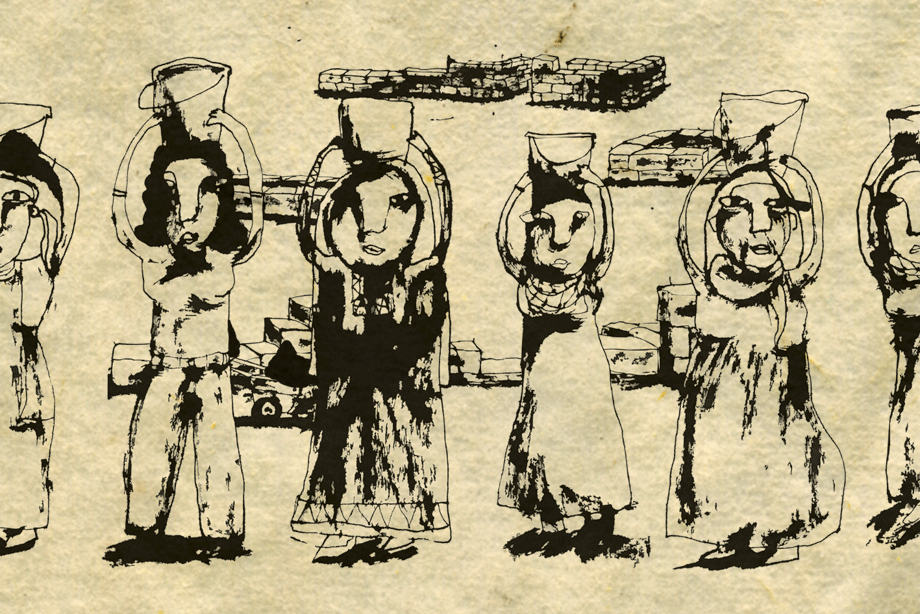
The Kingdom Of Women
The Kingdom Of Women ( Dahna Abourahme , Lebanon , 2010) documents an important chapter in the history of Palestinian refugee women in Lebanon . Weaving between past and present, animation and daily life, it honours how women continue to contribute to the survival of the community in exile while many of their men are imprisoned in Israel .

The Tenth Planet
Next came the spontaneous, shot-on-the-run The Tenth Planet ( Melis Birder , Iraq , 2004) , made when a lone Turkish woman filmmaker gained rare, covert access to women in Baghdad . Departing from the usual war coverage measured in dollars and body counts, it was a portrait of an unusual young woman, with whom we enter people's homes and other intimate spaces where we are privileged to hear their candid opinions about many things, including the American occupation.
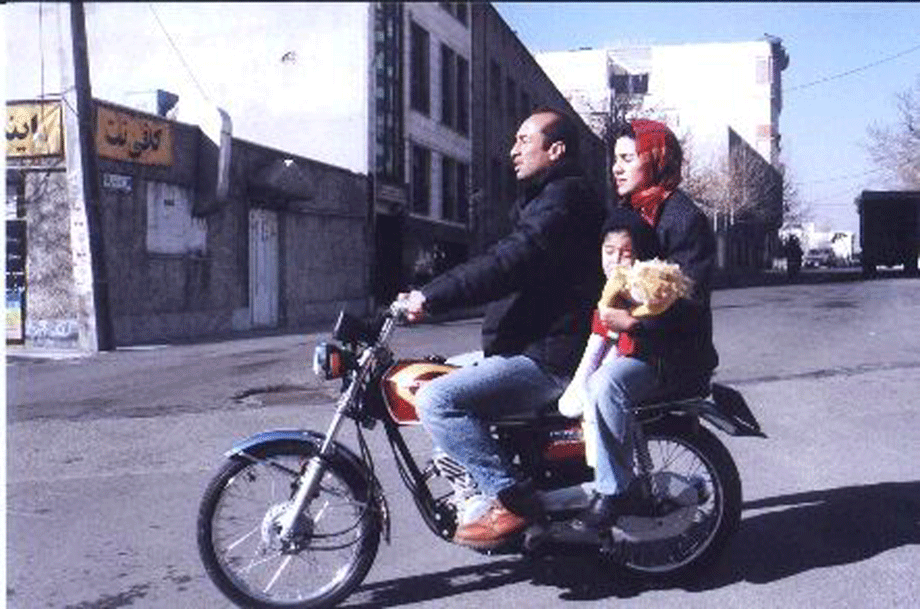
The closing film was 20 Fingers ( Mania Akbari , Iran - UK , 2004) . This fiction feature in six stunning single-shot episodes explores a man-woman couple's attitudes and interactions in different life situations.
These three films showed the spirit of a range of women in West Asian countries, whom the rest of the world often stereotypes as submissive and backward. The individuality and assertiveness of these women in the face of patriarchal oppression, violence, conflict and occupation was good to experience, and to take away.
Throughout the festival, the small but enthusiastic audiences engaged deeply with the filmmakers, panelists and with each other to arrive at a deeper awareness of certain concerns and express their own insights into the difficult human and social issues as well as the aesthetic and cinematic choices and strategies that the festival sought to highlight. Ultimately this is what makes such events worth the time, effort and resources used.
(Note: Synopses of the more than 200 titles that make up the two Our Lives…To Live editions are available from IAWRT, along with programming guides. All non-English language films and videos have English subtitles. Both editions have the tagline ‘films of courage, protest, hope', and comprise films from across the world. Selected DVDs may be borrowed at no charge for non-commercial screenings for travelling OLTOL film festival packages.)
contact: [email protected] ; [email protected]
.
Comments are moderated

